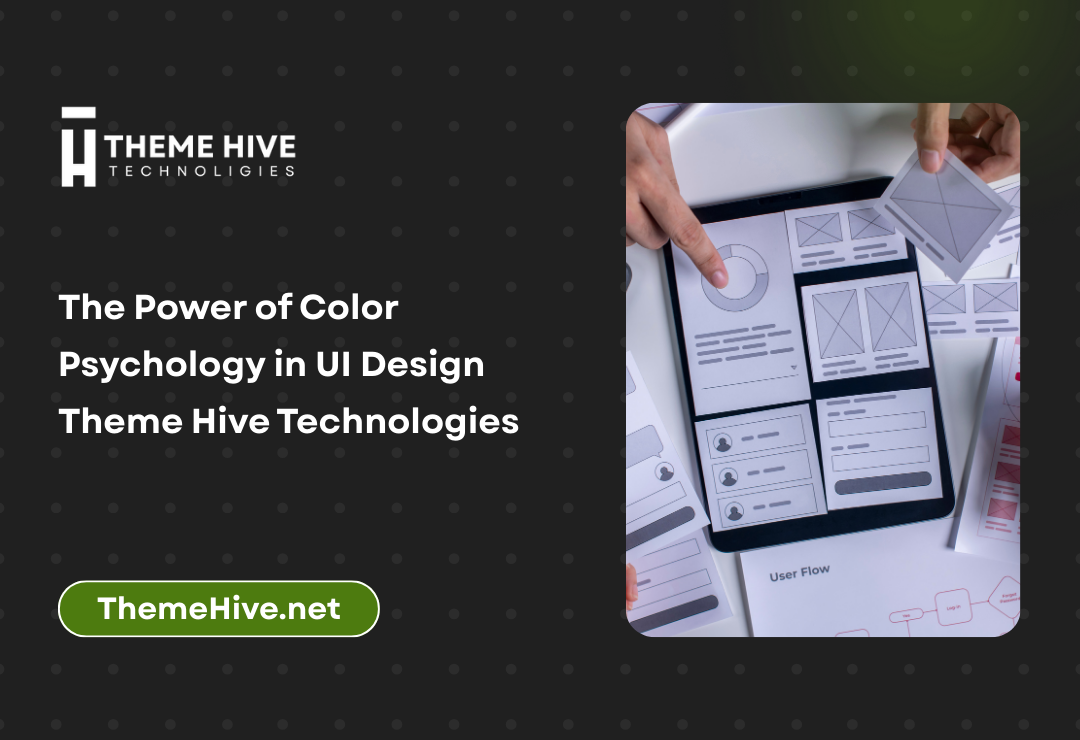Color is one of the most powerful tools in a UI designer’s arsenal, capable of evoking emotions, guiding user behavior, and creating memorable digital experiences. Understanding color psychology in user interface design goes beyond aesthetic preferences – it’s about leveraging the subconscious impact colors have on human perception, decision-making, and user engagement. In today’s competitive digital landscape, mastering color psychology can be the difference between a interface that merely functions and one that truly resonates with users.
At Theme Hive Technologies, we understand that strategic color implementation is crucial for creating successful digital experiences that drive user engagement and business results.
Thme Hive Technologies
Understanding the Fundamentals of Color Psychology
Color psychology is the study of how colors affect human behavior, emotions, and cognitive processes. This field of research has revealed that colors can trigger specific psychological responses, influence mood states, and even impact physiological reactions like heart rate and blood pressure. In UI design, these principles become invaluable tools for creating interfaces that not only look appealing but also guide users toward desired actions and create positive user experiences.
The human brain processes visual information remarkably quickly – within 90 seconds of initial viewing, people make subconscious judgments about products, and between 62% and 90% of that assessment is based on color alone. This statistic underscores the critical importance of strategic color selection in digital interface design.
Different cultures and demographics may interpret colors differently, adding another layer of complexity to color psychology in UI design. What represents prosperity in one culture might symbolize mourning in another. Successful UI designers must consider their target audience’s cultural background, age demographics, and regional preferences when making color decisions.
TheneHive Technologies has extensive experience working with global clients, understanding how cultural nuances impact color perception and user interface effectiveness across different markets.
The Emotional Impact of Primary Colors in Digital Interfaces
Red: Energy, Urgency, and Action
Red is perhaps the most psychologically powerful color in the designer’s palette. It naturally draws attention, increases heart rate, and creates a sense of urgency. In UI design, red is frequently used for call-to-action buttons, error messages, and notifications that require immediate attention. However, red must be used judiciously – overuse can create anxiety and overwhelm users.
E-commerce platforms often leverage red for sale tags, clearance notifications, and “limited time” offers because it psychologically communicates scarcity and urgency. The color’s association with passion and excitement makes it particularly effective for brands targeting younger demographics or those in entertainment, food, and fashion industries.
Thme Hive Technologies
Blue: Trust, Stability, and Professionalism
Blue consistently ranks as the most preferred color across various cultures and demographics, making it a safe yet powerful choice for UI design. Its psychological associations with trust, reliability, and professionalism explain why it’s prevalent among financial institutions, healthcare platforms, and corporate websites. Blue has a calming effect on users, reducing anxiety and creating a sense of security.
Different shades of blue convey varying messages – navy blue suggests authority and expertise, while lighter blues feel more approachable and friendly. Social media platforms like Facebook and LinkedIn have built their brand identities around blue, reinforcing trust and encouraging users to share personal information and connect with others.
Yellow: Optimism, Creativity, and Attention
Yellow is psychologically associated with happiness, creativity, and mental stimulation. In UI design, yellow works exceptionally well as an accent color for highlighting important information or creating cheerful, energetic interfaces. However, pure yellow can be challenging to read against white backgrounds, so designers often use golden or muted yellow tones for better accessibility.
The color’s attention-grabbing properties make it effective for warning messages (though less severe than red) and for drawing focus to specific interface elements. Yellow’s association with innovation and creativity makes it popular among tech startups and creative agencies.
Secondary Colors and Their Psychological Applications
Green: Growth, Harmony, and Success
Green’s psychological connections to nature, growth, and harmony make it an excellent choice for brands emphasizing sustainability, health, or financial success. In UI design, green is commonly used for positive feedback, success messages, and “go” actions. Its calming properties help reduce eye strain, making it suitable for applications where users spend extended periods.
The color’s association with money and prosperity explains its prevalence in financial apps and investment platforms. Different shades convey different messages – forest green suggests stability and tradition, while bright lime green feels more modern and energetic.
Purple: Luxury, Creativity, and Innovation
Purple has historically been associated with royalty, luxury, and sophistication due to the rarity and expense of purple dyes in ancient times. In modern UI design, purple works well for brands positioning themselves as premium or innovative. The color stimulates creativity and imagination, making it popular among design tools, creative platforms, and luxury brands.
Lighter purples (lavender, lilac) feel more feminine and calming, while deeper purples convey authority and elegance. The color’s uniqueness helps brands stand out in crowded marketplaces, though it may not appeal to all demographics.
Orange: Enthusiasm, Warmth, and Friendliness
Orange combines the energy of red with the happiness of yellow, creating a warm, enthusiastic, and approachable feeling. In UI design, orange works well for brands wanting to appear friendly and accessible without the aggressive intensity of red. It’s particularly effective for call-to-action buttons and interactive elements.
The color’s association with creativity and enthusiasm makes it popular among creative agencies, entertainment platforms, and brands targeting younger audiences. Orange can stimulate appetite, explaining its prevalence in food and restaurant applications.
Strategic Color Application in User Interface Elements
Navigation and Menu Systems
Color psychology plays a crucial role in navigation design, helping users understand interface hierarchy and find their way through complex digital environments. Consistent color coding helps users develop mental models of how your interface works, reducing cognitive load and improving usability.
Active states, hover effects, and selected items should use colors that clearly indicate their status while maintaining visual harmony with the overall design. Warm colors tend to advance visually, making them effective for highlighting current pages or selected items, while cool colors recede, making them suitable for background navigation elements.
Call-to-Action Buttons and Conversion Elements
The psychology behind CTA button colors can significantly impact conversion rates. Red and orange typically perform well for urgent actions like “Buy Now” or “Sign Up Today,” while blue works better for informational actions like “Learn More” or “Download Guide.” The key is creating sufficient contrast with surrounding elements while aligning with users’ psychological expectations.
A/B testing different color combinations for CTA buttons often reveals surprising insights about user behavior and preferences specific to your audience. What works for one demographic or industry may not work for another, emphasizing the importance of data-driven color decisions.
According to research by Nielsen Norman Group, color choice can impact conversion rates by up to 80% when properly optimized for the target audience and brand context.
Forms and Input Fields
Form design benefits tremendously from strategic color application. Error states typically use red to immediately communicate problems, while success states use green to provide positive feedback. Neutral colors like gray work well for placeholder text and inactive elements, while highlighting active input fields with brand colors improves user focus and engagement.
Progressive form completion can be visually reinforced through color, with completed sections showing in success colors and remaining sections in neutral tones. This psychological progression helps motivate users to complete longer forms.
Cultural Considerations and Global UI Design
Western vs. Eastern Color Interpretations
Color meanings vary significantly across cultures, requiring careful consideration for global applications. While white represents purity and innocence in Western cultures, it symbolizes mourning and death in many Asian cultures. Red signifies good fortune and prosperity in China but danger and warning in Western contexts.
Understanding these cultural nuances becomes critical when designing interfaces for global audiences. Successful international brands often adapt their color schemes for different regions while maintaining overall brand recognition through consistent application of secondary design elements.
ThmeHive Technologies
Age and Gender Demographics
Color preferences often correlate with age and gender demographics, though these patterns are evolving as social norms change. Traditional research suggested women prefer softer, warmer colors while men gravitate toward bolder, cooler tones. However, modern UI design increasingly focuses on functional color choices that serve user needs rather than reinforcing stereotypes.
Younger users often respond well to vibrant, high-contrast color schemes, while older demographics may prefer more subdued, high-readability color combinations. Accessibility considerations become particularly important when designing for older users or those with visual impairments.
Accessibility and Inclusive Color Design
Color Contrast and Readability
Effective color psychology in UI design must balance emotional impact with accessibility requirements. WCAG guidelines specify minimum contrast ratios between text and background colors to ensure readability for users with visual impairments. These technical constraints shouldn’t limit creative expression but rather guide designers toward more inclusive solutions.
Tools like contrast checkers and color blindness simulators help designers verify that their color choices work for all users. The goal is creating interfaces that leverage color psychology while remaining functional for people with various visual abilities.
Adobe Color provides excellent tools for creating accessible color palettes that maintain psychological impact while meeting WCAG guidelines. Theme Hive Technologies integrates these accessibility considerations into every design project to ensure inclusive user experiences.
Color-Blind Friendly Design
Approximately 8% of men and 0.5% of women experience some form of color blindness, making color-blind friendly design essential for inclusive UI development. This doesn’t mean avoiding color entirely but rather ensuring that color isn’t the sole method of conveying important information.
Effective strategies include using patterns, icons, or text labels alongside color coding, choosing color combinations that work for common forms of color blindness, and testing designs with color blindness simulation tools. These approaches expand your interface’s usability without diminishing its psychological impact.
Testing and Optimizing Color Choices
A/B Testing Color Variations
Data-driven color decisions often outperform intuition-based choices. A/B testing different color variations for key interface elements reveals how your specific audience responds to different psychological triggers. This might involve testing warm vs. cool color schemes, high vs. low contrast combinations, or traditional vs. innovative color choices.
Successful color testing goes beyond conversion rates to include metrics like time on page, user engagement, and overall satisfaction scores. These broader measurements provide insight into how color choices affect the complete user experience.
Heat Mapping and User Behavior Analysis
Heat mapping tools reveal how users interact with different colored elements, providing valuable insights into the effectiveness of color psychology applications. Areas that receive more attention, clicks, or hover activity indicate successful color choices, while ignored elements might benefit from different color treatments.
User behavior analysis can reveal unexpected patterns in how people respond to color choices, leading to iterative improvements in interface design. This data-driven approach helps designers move beyond assumptions toward evidence-based color strategies.
Industry-Specific Color Psychology Applications
E-commerce and Retail Platforms
Online retail environments benefit significantly from strategic color psychology application. Product categories often use consistent color coding to help users navigate large inventories, while promotional elements use attention-grabbing colors to highlight special offers and deals.
Trust indicators like security badges and payment options typically use colors associated with reliability and safety, while product imagery and descriptions may use colors that enhance perceived value and desirability. The entire purchase funnel can be optimized through thoughtful color application.
Healthcare and Medical Applications
Healthcare interfaces require careful balance between professional credibility and user comfort. Blue’s association with trust and reliability makes it popular for medical platforms, while green’s connection to health and wellness works well for fitness and nutrition applications.
Error states in medical applications require particular attention, as they may deal with critical information. Colors must clearly communicate urgency levels while avoiding unnecessary anxiety for patients and healthcare providers.
Financial Services and Banking
Financial applications leverage color psychology to build trust and communicate security. Blue dominates the industry due to its associations with stability and reliability, while green reinforces messages about growth and prosperity. Red requires careful application, as it might create anxiety around financial matters.
Investment platforms often use color coding to indicate gains (green) and losses (red), following established conventions that users expect. However, these applications must remain accessible to color-blind users through additional visual indicators.
Future Trends in Color Psychology for UI Design
Dynamic and Adaptive Color Schemes
Emerging technologies enable dynamic color schemes that adapt based on user behavior, time of day, device settings, or personal preferences. These systems leverage color psychology principles while personalizing the experience for individual users.
Machine learning algorithms can analyze user responses to different color combinations, gradually optimizing interfaces for maximum engagement and satisfaction. This personalized approach to color psychology represents the next evolution in user interface design.
Sustainable and Eco-Conscious Color Choices
Growing environmental awareness influences color psychology applications, with earth tones and natural colors gaining popularity among eco-conscious brands. Green psychology extends beyond traditional associations to encompass sustainability and environmental responsibility.
Dark mode interfaces, partially driven by energy conservation on OLED displays, require rethinking traditional color psychology applications. Colors that work well on light backgrounds may have different psychological impacts on dark backgrounds, requiring new research and testing approaches.
Conclusion
Color psychology in UI design represents a powerful intersection of art, science, and user experience strategy. Successful implementation requires understanding both the universal principles of color psychology and the specific needs of your target audience. The goal isn’t to manipulate users but to create interfaces that feel intuitive, trustworthy, and engaging.
As digital interfaces continue evolving, color psychology principles provide a stable foundation for creating meaningful user experiences. The key lies in balancing psychological impact with accessibility requirements, cultural considerations, and brand identity needs. Through careful testing, iteration, and user feedback, designers can harness the full power of color psychology to create interfaces that not only function well but truly resonate with users on an emotional level.
The future of UI design will likely see even more sophisticated applications of color psychology, driven by advances in personalization technology and deeper understanding of cross-cultural color preferences. Designers who master these principles while remaining adaptable to emerging trends will create the most compelling and effective digital experiences.
Internal Links
- Theme Hive Technologies Homepage
- About Theme Hive Technologies
- Our UI/UX Design Services
- Latest Design Articles & News
- Contact Our Design Team







